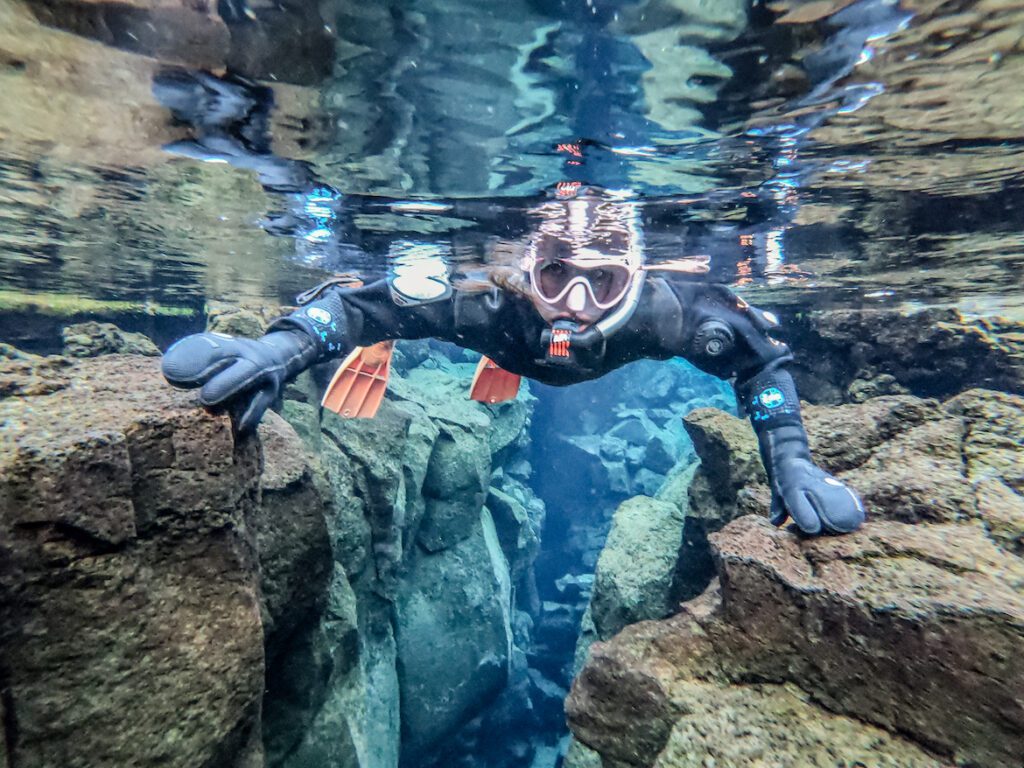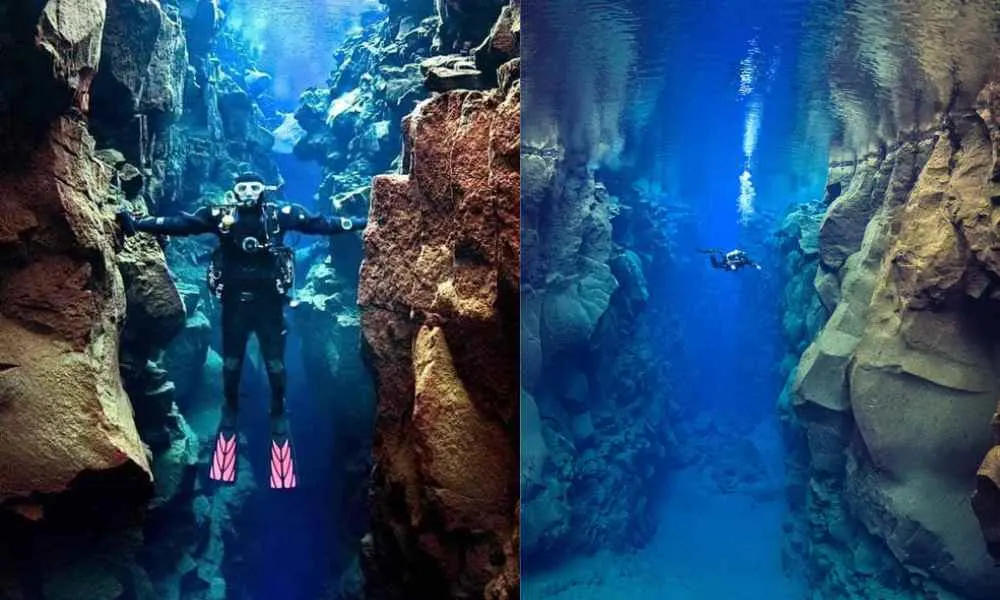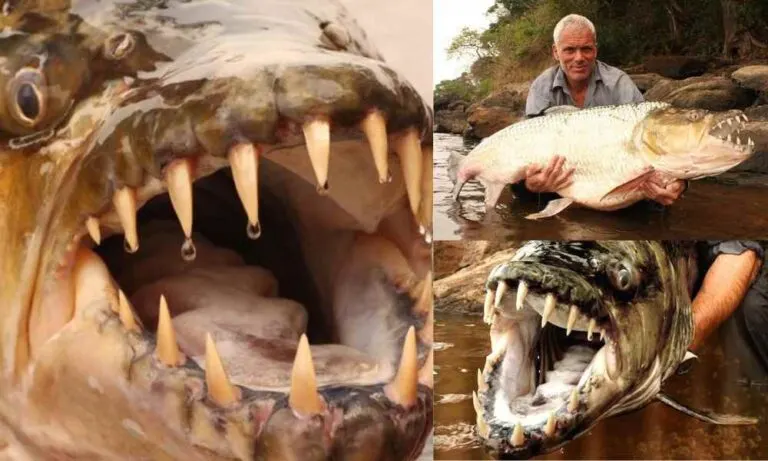The Only Place In The World Where You Can Swim Between Two Tectonic Plates!
Have you ever thought of swimming between two gigantic tectonic plates? Well, there is a rare wonder in Iceland where you can actually swim in the gap that separates continents. This unique experience is placed within a crack where the North American and Eurasian tectonic plates meet. This gap between is so narrow at certain points and guess what? it gives divers a chance to touch both North America and Europe at once!
Adventurers seeking to explore this underwater wonder will find themselves in icy waters that are as clear as crystal. This is known as the only place on Earth where diving between two tectonic plates is possible. The dive site exceeds 100 meters thanks to the glacial meltwater that fills the fissure. The water is filtered through porous underground lava for nearly a century before it emerges. Let’s dive in to know more about this geological marvel.
Stunning Underwater Boundary Between the Eurasian and North American Tectonic Plates
In the remarkable landscape of Thingvellir National Park, sits the Silfra fissure. It is an underwater canyon marking the boundary between two colossal tectonic plates. Divers and adventurers are drawn to its beauty and the opportunity to swim between two tectonic plates. According to sources, North American and European plates are drifting apart at a rate of approximately 2 cm per year.
Location:
- Country: Iceland
- Park: Thingvellir National Park
- Coordinates: 64°15′23″N 21°7′2″W
The discovery of Silfra and subsequent geological research have revealed the unimaginable history of this site. Born from the earthquakes that ripple through the region as the tectonic plates shift, Silfra is a testament to the fiery nature of Earth’s crust.
Depth and Clarity:
- Maximum Depth: Over 60 meters
- Visibility: Up to 100 meters due to the glacial meltwater filtration through underground lava.
What sets Silfra apart is not just its location—it’s the water clarity and the mystical experience it offers. The fissure is filled with glacial water so pure that visibility often extends beyond 100 meters. Divers are keen on experiencing the astounding visibility and the sensation of floating in such a space. The Silfra fissure is indeed evidence of the planet’s endless change and the forces that continuously shape its surface.

Geology of The Fissure of Silfra
Silfra is a unique geological formation located within Thingvellir National Park in Iceland. It is a fissure that marks the boundary between the North American and Eurasian tectonic plates.
- Formation Process
- Created by tectonic movements
- Plates drift approximately 2 cm per year
These plates are slowly drifting apart, and this movement has created Silfra and other cracks in the area over thousands of years. The clear, cold waters of Silfra make Silfra a premier dive site.
Water Temperature
- Between 2°C and 4°C
- Unique clarity due to filtration through underground lava
The water temperatures in Silfra remain nearly constant between 2°C and 4°C. This is due to the water being filtered through underground lava for up to a century before it emerges in the fissure. The process contributes to its remarkable clarity.
Geological History
- Earthquakes play a role in fissure formation
- Notable fissure due to directly observable tectonic drift
Earthquakes have been instrumental in Silfra’s creation, with the last major event occurring in 1789. These earthquakes cause the earth to crack and create the fissures visible in Thingvellir.
The Four Sections of Silfra
The Silfra fissure is divided into four separate sections, each offering a unique perspective to divers and snorkelers.
Silfra Big Crack: This section is quite literally a narrow crack, where the North American and Eurasian tectonic plates are almost close enough to touch. The Big Crack is notable for being the deepest point of the fissure, with depths reaching 45 meters.
Silfra Hall: As divers progress from the Big Crack, they enter the wider expanse known as Silfra Hall. It’s spacious compared to the tight confines of the previous section and provides ample room to swim and admire the rock formations on either side of the continental divide.
Silfra Cathedral: Known for its impressive visibility that often extends over 100 meters, the Silfra Cathedral is a majestic section of the fissure. The long, straight channel here creates an unearthly feeling of flying between tectonic plates.
Silfra Lagoon: Towards the end of the fissure lies the Silfra Lagoon. It’s a serene end to the journey through Silfra, featuring incredibly clear water and a perfect spot to reflect on the unique underwater journey.
Each of these areas showcases the geological marvel of the Silfra Fissure, giving visitors a literal hands-on connection with the earth’s dynamic forces.

Clearest Water In The World For Scuba Diving!
When it comes to scuba diving, visibility is essential but crucial to meet. Silfra Fissure in Iceland has the clearest water in the world for diving, making it a top destination for crystal-clear experiences. The water in Silfra originates as a glacial melt from the Langjökull glacier. This meltwater travels for decades through hardened, porous lava rock, filtering it naturally and creating exceptional underwater clarity.
The unique geological conditions of the fissure result in an underwater environment with visibility reaching up to 120 meters. Any particles are thoroughly removed before the water reaches the fissure.
- Water Source: Langjökull glacier
- Filtration: Through hardened lava rock
- Visibility: Up to 120 meters
- Benefit: Optimal underwater clarity for scuba diving
Scuba divers traveling to this location can enjoy a one-of-a-kind experience by (floating between two continents). The fissure is actually a rift between the North American and Eurasian tectonic plates, a spot where the Earth’s massive plates separate slightly each year.
The purity of the water not only provides an incredible field of view but also contributes to the feeling of immersion in an otherworldly environment. This level of visibility is rare and sought after, making Silfra a bucket-list destination for scuba divers from around the globe.
Snorkeling in Silfra
Preparations for this activity require a dry suit and snorkeling gear, often provided by tour operators. Due to the frigid temperatures, snorkelers must wear suits designed to keep them warm, even as water temperatures hover between 2-4°C (35-39°F). A brief on safety procedures and communication signals precedes the dive.
During the dive, individuals experience 50 to 100 meters of underwater visibility, witnessing a striking underwater world of vibrant blue hues, interesting rock formations, and aquatic life. Snorkelers should be prepared for the physical demands of swimming in cold water and managing the slight current.
Requirements for snorkeling at Silfra include a moderate level of fitness and the ability to swim comfortably. Children above at least 12 years of age and adults are welcome, but there are typically height and weight restrictions to ensure the gear fits correctly for safety.
According to Guide to Iceland, following are some other requirements that needs to be fulfilled by the divers.
- A height of at least 4’9″ feet (145 centimeters) tall and weigh at least 99 lbs (45 kilograms)
- Not taller than 6’5″ feet (200 cm) or weigh over 265 (120 kilograms)
- Not pregnant
- Divers/Snorkelers over sixty require a medical waiver
- Divers/Snorkelers over forty-five with a history of heavy alcohol use and pipe smoking also require a waiver
Diving in Silfra
The visibility in Silfra’s crystal-clear waters can surpass 100 meters, providing an unparalleled underwater experience.
Preparations for Diving:
- Certification: Divers must have a dry suit certification or a minimum of 10 logged dry suit dives over the last two years.
- Equipment: Essential gear includes a dry suit, mask, fins, and an underwater camera to capture the stunning clarity of the water.
Diving Conditions:
- Temperature: The water remains consistently near 2°C (35°F), requiring divers to wear appropriate thermal protection.
- Depth: Diving depths in Silfra range from the shallows of the Big Crack to depths of 18 meters in the Silfra Cathedral.
What To Expect Down The Fissure
Upon entry, divers are greeted by the mesmerizing Big Crack, Silfra’s narrowest section, where the continental plates are close enough to touch. Descending further, the Silfra Hall opens up leading to the majestic Silfra Cathedral; the site’s deepest and most awe-inspiring section. Last but not least, the Silfra Lagoon provides a gentle finish to the dive with its sandy bottom and ample light.
Reported Deaths in Silfra Fissure
Silfra Fissure, has been a site of both awe and tragedy with a number of deaths and accidents. Over the past seven years, there have been nine serious accidents, including four fatalities.
Despite the professional guidance typically provided, some participants find the experience overwhelming. As they face the realities of the cold, deep water, a number of them abandon their diving trip upon entry. Various factors contribute to these premature terminations, ranging from sudden panic attacks, water phobia to a sobering reassessment of personal swimming skills.
The inherent allure of Silfra is undeniable, yet these occurrences serve as a reminder of nature’s unpredictability and the paramount importance of respect and preparedness in the face of adventure tourism.
Conclusion
Swimming between two tectonic plates presents a rare opportunity to experience Earth’s geological phenomena up close. In places like Silfra, Iceland, adventurers can float in frigid waters where the North American and Eurasian Plates drift apart each year. This experience underscores the dynamic nature of the planet’s lithosphere.
Divers and snorkelers witness first-hand the clarity of subaquatic visibility and the unique marine ecosystems that thrive in these fissures. The motion of these massive plates shapes the Earth’s surface over time, leading to the creation of new topographical features and, occasionally, seismic activity. Engaging in this underwater journey, individuals gain a vivid appreciation for the ongoing processes that have sculpted the Earth’s landscape over millions of years.
FAQ’s
Silfra is a rift formed along the divergent tectonic plate boundary between the North American and Eurasian plates. This fissure is directly influenced by the plates’ separation.
Yes, you can swim or dive in the Silfra fissure, one of the few places in the world where such an activity is possible due to the clear waters and the presence of the continental rift.
The Silfra fissure offers a unique and breathtaking experience, renowned for its crystal-clear waters and the thrill of swimming between continental plates, making it a bucket-list destination for many adventurers.
Fatalities at Silfra are extremely rare due to stringent safety protocols and guided tours, with only a handful of incidents reported over the years.
Also read,
This Man Climbed The Tallest Granite Rock In The World With No Aids!







